User Guide
TutorsGo is a desktop app for tutors to manage student details, optimized for use via a Command Line Interface (CLI) while still having the benefits of a Graphical User Interface (GUI). If you can type fast, TutorsGo can get your contact management tasks done faster than traditional GUI apps.
- Why TutorsGo?
- Quick start
-
Features
- Viewing help :
help - Adding a student :
add - Listing all students :
list - Editing a student :
edit - Locating students by name :
find - Filter student by grade / subject :
filter - Categorise student by payment :
payment - View Schedule :
view - Deleting a student :
delete - Command history :
history - Clearing all entries :
clear - Exiting the program :
exit - Saving the data
- Editing the data file
- Viewing help :
- FAQ
- Known issues
- Command summary
Why TutorsGo?
- Calendar Integration: Seamlessly plan tutoring sessions with an integrated calendar view, enabling easy lookup of upcoming lessons and schedules.
- Comprehensive Student Profiles: Access student grades, subjects, notes and more at your fingertips, allowing for easy lookup of everything you need to know about your student.
- Payment Tracking Made Simple: Keep tabs on payments effortlessly, ensuring financial matters are organized and up-to-date.
Quick start
-
Ensure you have Java
11or above installed in your Computer. -
Download the latest
.jarfrom here. -
Copy the file to the folder you want to use as the home folder for your AddressBook.
-
Open a command terminal,
cdinto the folder you put the jar file in, and use thejava -jar <version_no>.jarcommand to run the application.
A GUI similar to the below should appear in a few seconds. Note how the app contains some sample data.
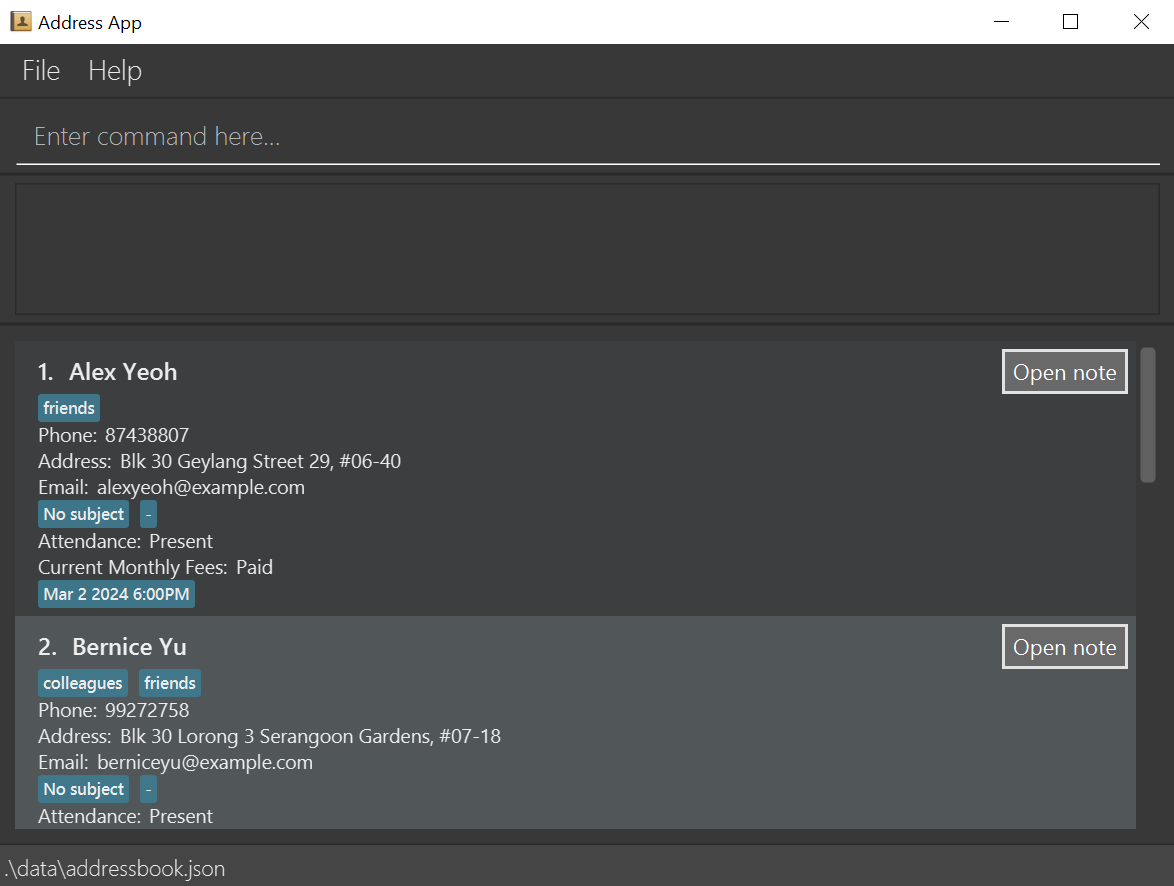
-
Type the command in the command box and press Enter to execute it. e.g. typing
helpand pressing Enter will open the help window.
Some example commands you can try:-
list: Lists all contacts. -
add n/John Doe p/98765432 e/johnd@example.com a/John street, block 123, #01-01 s/English at/present pa/paid d/2024-02-03 1800: Adds a contact namedJohn Doeto the Address Book. -
delete 3: Deletes the 3rd contact shown in the current list. -
clear: Deletes all contacts. -
exit: Exits the app.
-
-
Refer to the Features below for details of each command.
Features
![]() Notes about the command format:
Notes about the command format:
-
Words in
UPPER_CASEare the parameters to be supplied by the user.
e.g. inadd n/NAME,NAMEis a parameter which can be used asadd n/John Doe. -
Items in square brackets are optional.
e.gn/NAME [t/TAG]can be used asn/John Doe t/friendor asn/John Doe. -
Items with
… after them can be used multiple times including zero times.
e.g.[t/TAG]…can be used ast/friend,t/friend t/familyetc. -
Parameters can be in any order.
e.g. if the command specifiesn/NAME p/PHONE_NUMBER,p/PHONE_NUMBER n/NAMEis also acceptable. -
Extraneous parameters for commands that do not take in parameters (such as
help,view,list,exitandclear) will be ignored.
e.g. if the command specifieshelp 123, it will be interpreted ashelp. -
GRADEparameter input (i.e.g/GRADE) follows the NUS grading system. (i.e. [A+, A, A-, B+, B, B-, C+, C, D+, D, F]) -
GRADEandSUBJECTare currently both independent fields, i.e.GRADEcan be assigned despite not having aSUBJECT. -
At most 1
GRADEand 1SUBJECTcan be assigned per student. -
You can view a student’s note by clicking on the Note button beside the student. The note can be edited using the
editcommand (refer to usage below for more information). -
PAYMENTshould either bePaidorNot Paidwith case-insensitive input or-for not available payment status. (i.e.,paidorPAIDare valid inputs) -
PAYMENTparameter input (i.e.pa/PAYMENT), is displayed exactly as it appears in the output. (i.e., InputPaIdwill be displayed asPaId) -
ATTENDANCEshould either bePresentorAbsentwith case-insensitive input. (i.e.,presentorPRESENTare valid inputs) -
DateTimeparameter should be in yyyy-mm-dd hhmm and a valid date i.e.2024-03-02 1800 -
If you are using a PDF version of this document, be careful when copying and pasting commands that span multiple lines as space characters surrounding line-breaks may be omitted when copied over to the application.
Viewing help : help
Opens a help window summarising all commands available.
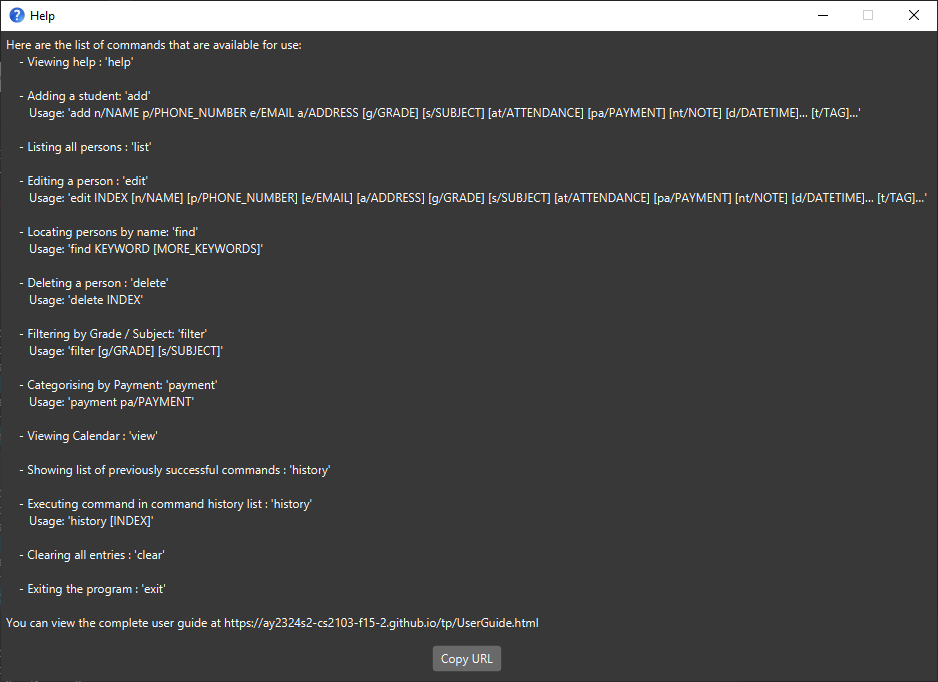
Format: help
Adding a student : add
Adds a student to the address book.
Format: add n/NAME p/PHONE_NUMBER e/EMAIL a/ADDRESS [g/GRADE] [s/SUBJECT] [at/ATTENDANCE] [pa/PAYMENT] [nt/NOTE] [d/DATETIME]… [t/TAG]…
- Refer to Features to view the accepted input parameters, parameters should only include what is specified without any other characters.
Examples:
add n/John Doe p/98765432 e/johnd@example.com a/John street, block 123, #01-01 g/B+ s/Mathematics d/2024-02-03 1800add n/Betsy Crowe t/friend e/betsycrowe@example.com a/Betsy Avenue p/91234567
Listing all students : list
Shows a list of all students in the address book.
Format: list
Editing a student : edit
Edits an existing student in the address book.
Format: edit INDEX [n/NAME] [p/PHONE_NUMBER] [e/EMAIL] [a/ADDRESS] [g/GRADE] [s/SUBJECT] [at/ATTENDANCE] [pa/PAYMENT] [nt/NOTE] [d/DATETIME]… [t/TAG]…
- Edits the student at the specified
INDEX. The index refers to the index number shown in the displayed student list. The index must be a positive integer 1, 2, 3, … - At least one of the optional fields must be provided.
- Existing values will be updated to the input values.
- When editing tags, the existing tags of the student will be removed i.e adding of tags is not cumulative.
- You can remove all the student’s tags by typing
t/without specifying any tags after it. - You can remove all the student’s datetime by typing
d/without specifying any datetime after it. - Refer to Features to view the accepted input parameters, parameters should only include what is specified without any other characters.
Examples:
-
edit 1 p/91234567 e/johndoe@example.comEdits the phone number and email address of the 1st student to be91234567andjohndoe@example.comrespectively. -
edit 2 n/Betsy Crower t/Edits the name of the 2nd student to beBetsy Crowerand clears all existing tags.
Locating students by name : find
Finds students whose names contain any of the given keywords.
Format: find KEYWORD [MORE_KEYWORDS]
- The search is case-insensitive. e.g
hanswill matchHans - The order of the keywords does not matter. e.g.
Hans Bowill matchBo Hans - Only the name is searched.
- Only full words will be matched e.g.
Hanwill not matchHans - Students matching at least one keyword will be returned (i.e.
ORsearch). e.g.Hans Bowill returnHans Gruber,Bo Yang
Examples:
-
find JohnreturnsjohnandJohn Doe -
find alex davidreturnsAlex Yeoh,David Li
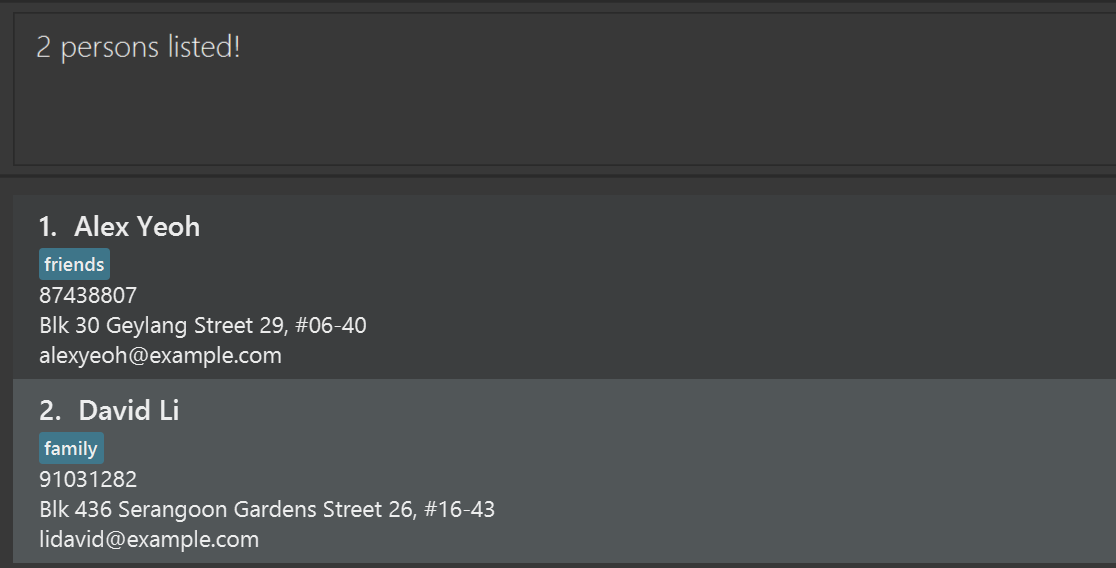
Filter student by grade / subject : filter
Filters and shows a list of students who has the specified grade and/or subject.
Entering list will bring back the full address book.
Format: filter [g/GRADE] [s/SUBJECT]
- Refer to Features to view the accepted grade inputs.
- Search is case-sensitive. (i.e.
filter s/Mathswill not matchfilter g/maths) - There can only be at most 1 grade and 1 subject when filtering.
- Only full words will be matched. (i.e.
filter s/Mathswill not matchfilter g/Math) - The order of keywords does not matter.
- At least one of the optional fields must be provided.
Examples:
-
filter g/Areturn students with grade:A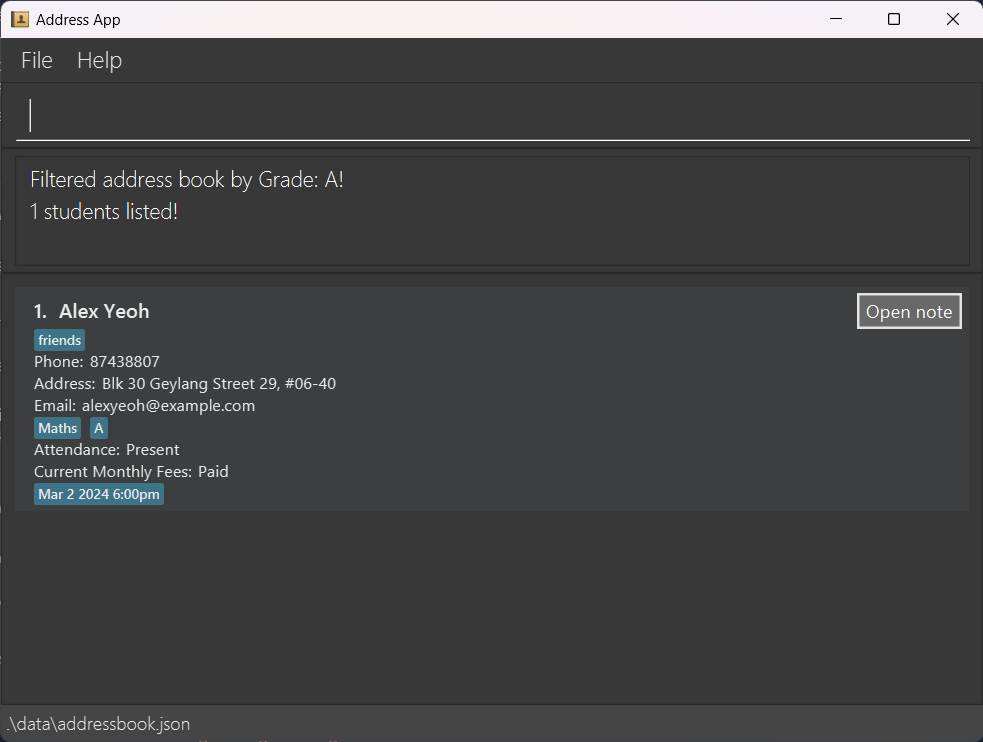
-
filter g/B+ s/Mathsreturns students with grade:B+and subject:Maths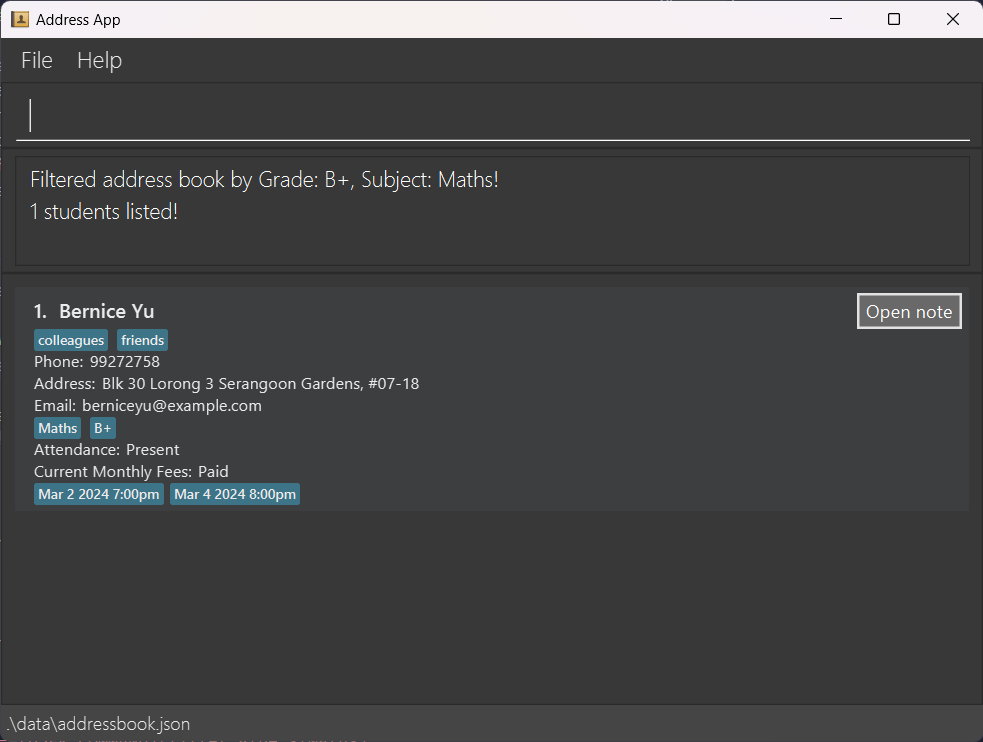
Categorise student by payment : payment
Categorise students who has Paid or Not paid
Format: payment pa/PAYMENT
- Refer to Features to view the accepted payment status.
- The search is case-insensitive. (i.e.
paidwill matchPAID) - Only full words will be matched. (i.e.
Not paidwill not matchNot p) - Only one payment status can be used to categorise at a time
Examples
-
payment pa/Paidreturn students with payment:Paid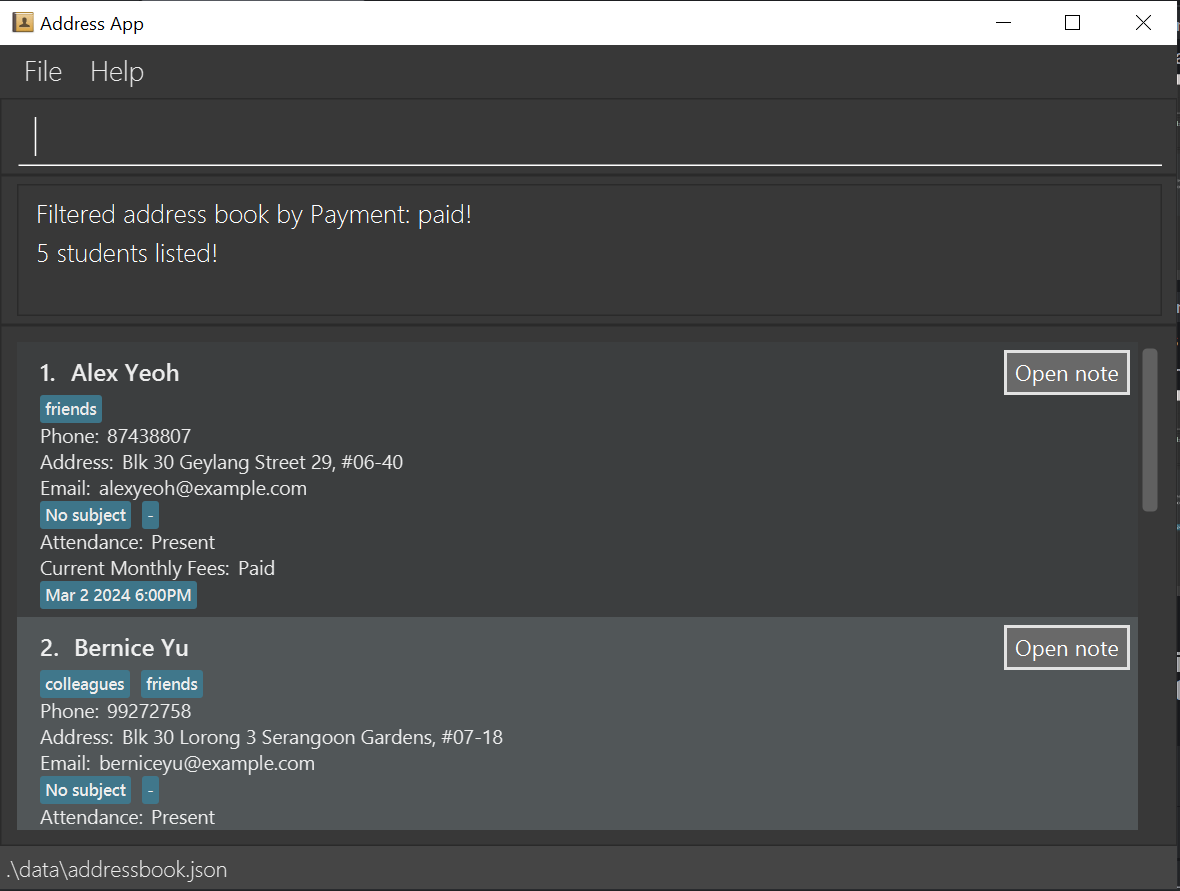
-
payment pa/Not Paidreturn students with payment:Not Paid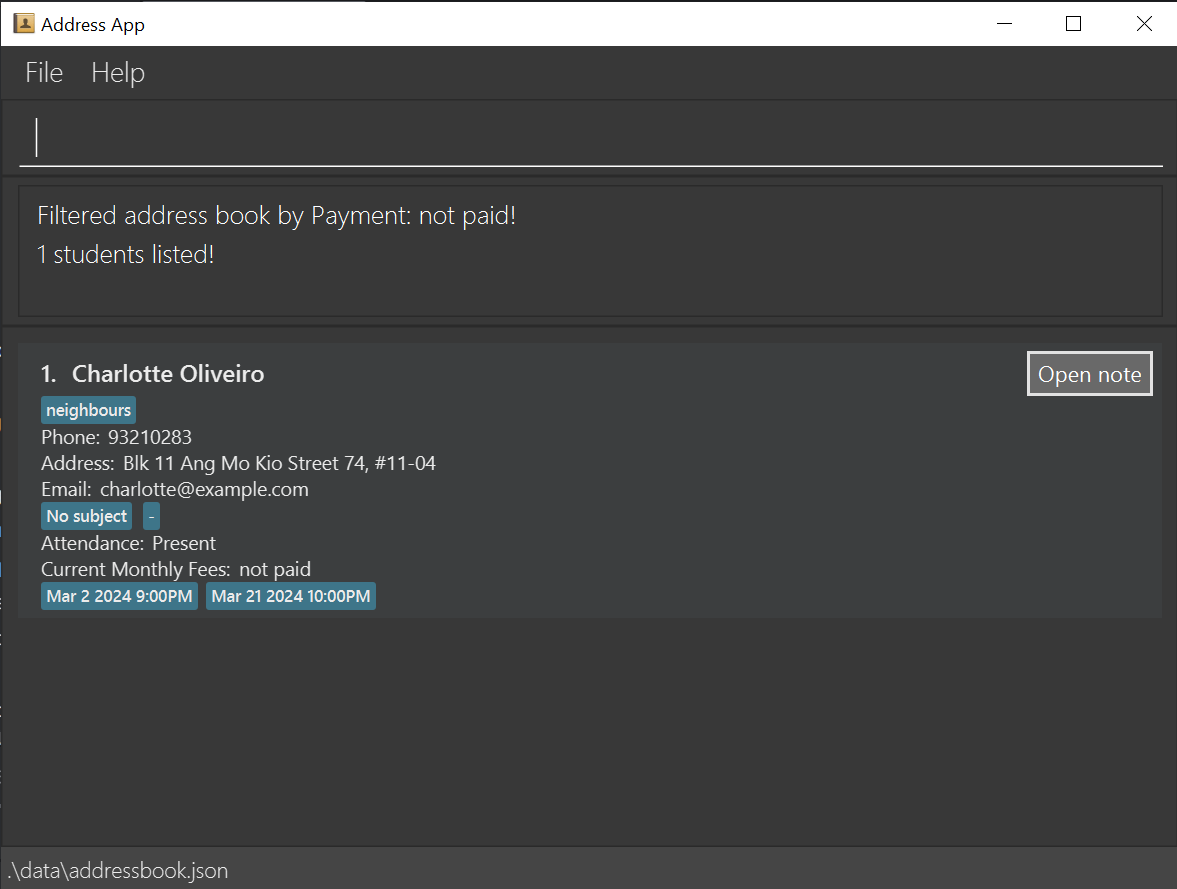
View Schedule : view
Displays a calendar to view scheduled classes.
Example:
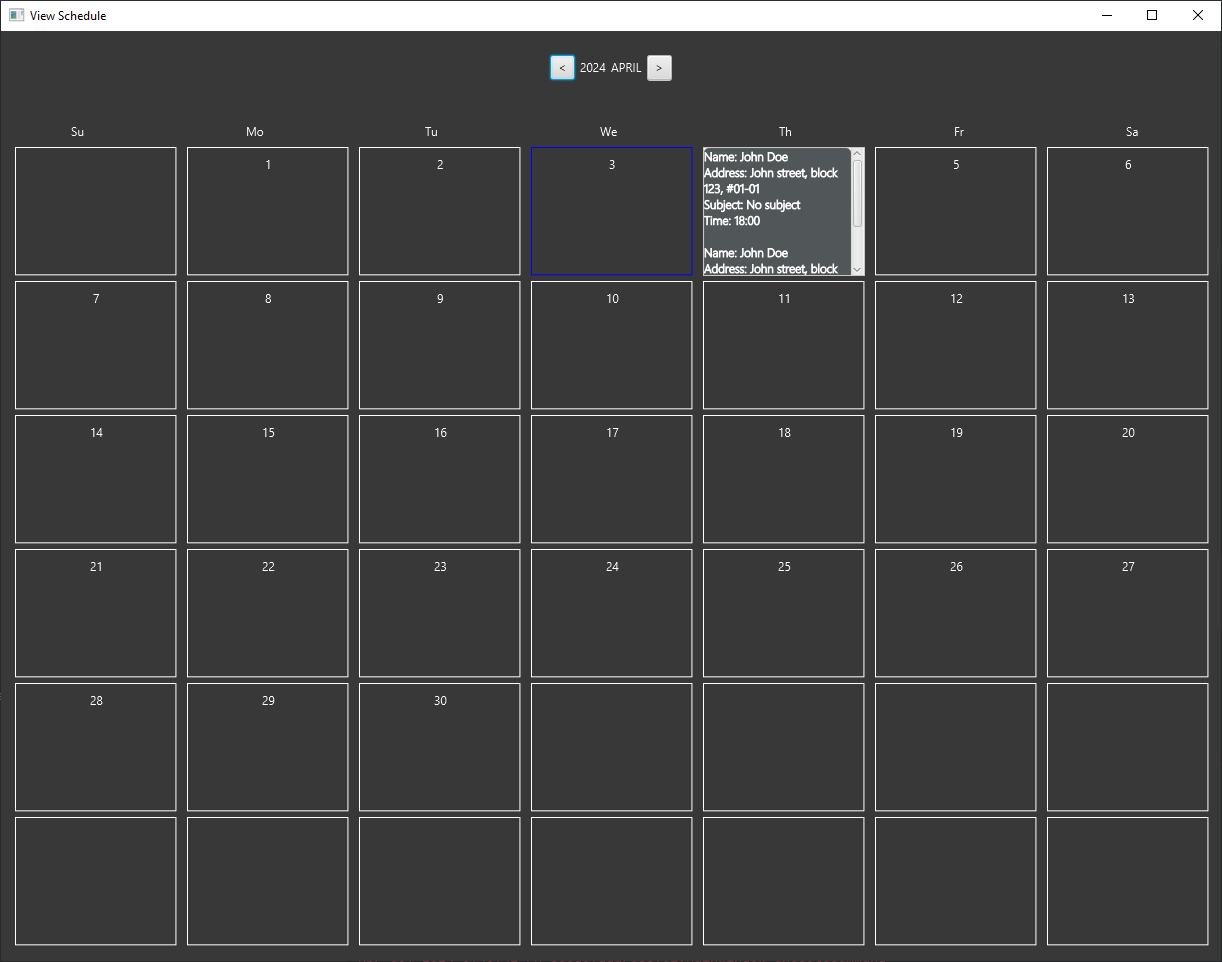
Format: view
Deleting a student : delete
Deletes the specified student from the address book.
Format: delete INDEX
- Deletes the student at the specified
INDEX. - The index refers to the index number shown in the displayed student list.
- The index must be a positive integer 1, 2, 3, …
Examples:
-
listfollowed bydelete 2deletes the 2nd student in the address book. -
find Betsyfollowed bydelete 1deletes the 1st student in the results of thefindcommand.
Command history : history
There are two differing behaviours for this function.
- Lists down the last 10 successful commands in an independent command history list.
- Re-run commands based on the specified index.
Enter list to return back to the student list.
Format syntax and more information below.
![]() Note:
Commands that are saved are not persistent. (i.e. The commands that are saved in one instance will be lost after closing the app.)
Note:
Commands that are saved are not persistent. (i.e. The commands that are saved in one instance will be lost after closing the app.)
Format: history [INDEX]
- Upon entering
history(i.e. leaving whitespace / not entering any index):- it will show a command history list, featuring a new, independent list showing previous successful commands.
- The command history list also ignores saving
historycommand itself. - Lists at most 10 successful commands.
- Upon entering
history [INDEX]:- It will re-run the command that was specified by the index.
- The index here refers to the index number shown in the command history list.
- The index must be a positive integer, and should be within the list’s boundaries.
- The output message is determined by the re-run command. (i.e.
history [INDEX]itself does not have any success message.)
Examples:
-
historyreturns a command history list.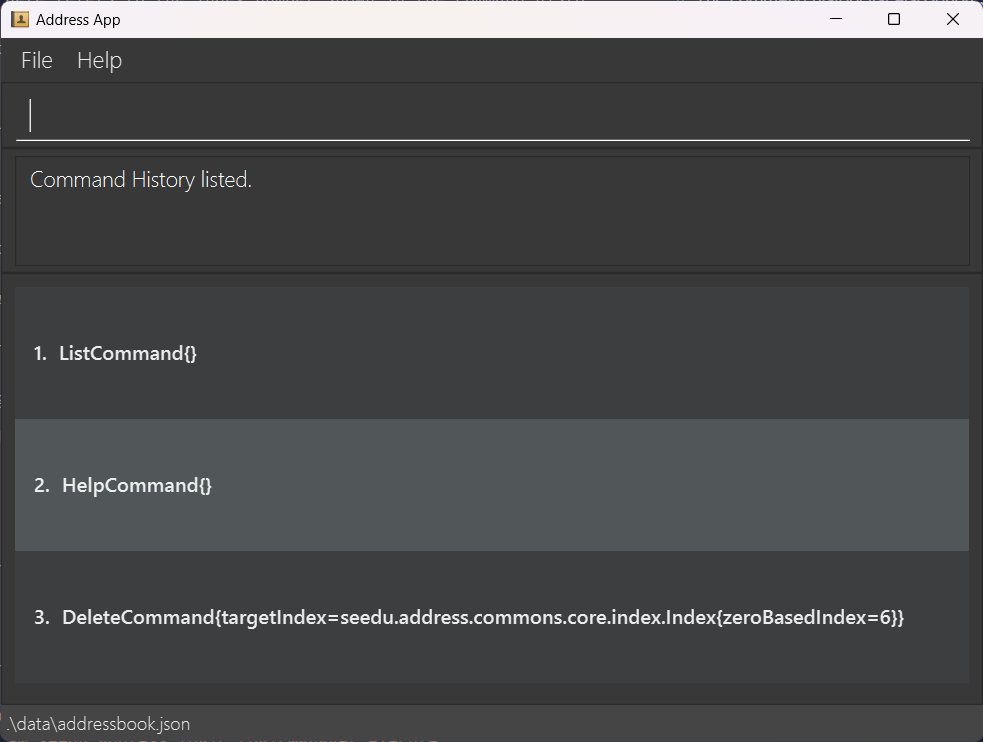
-
Upon running
history 1from the result above, it runs thelistcommand and returns the student list. It also outputs the success message oflist.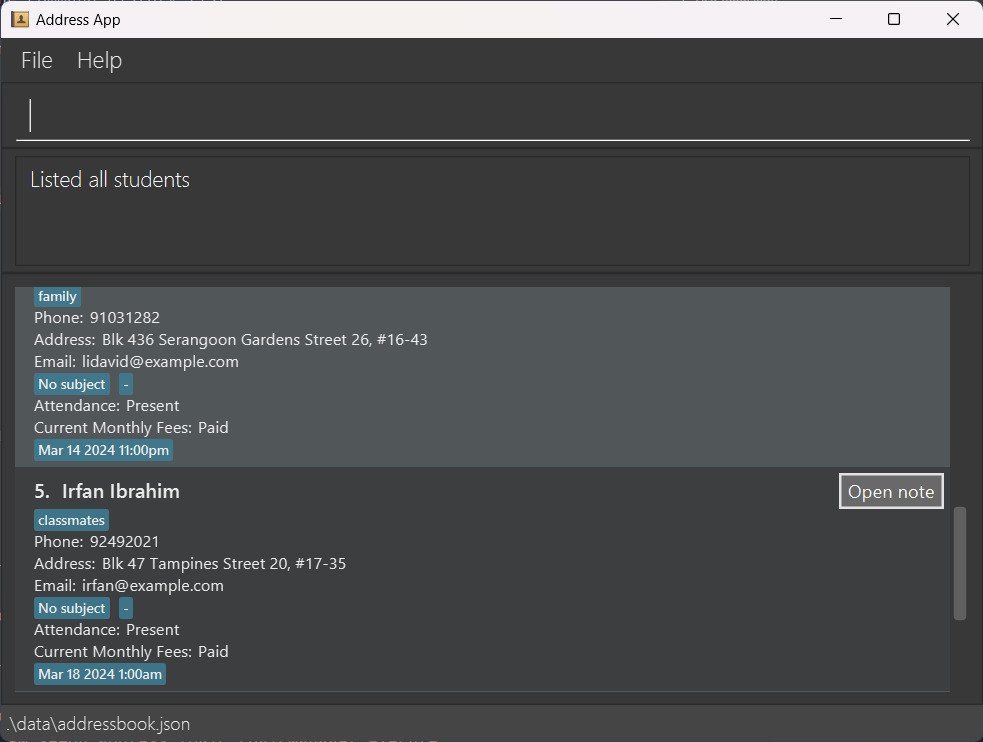
Clearing all entries : clear
Clears all entries from the address book.
Format: clear
Exiting the program : exit
Exits the program.
Format: exit
Saving the data
AddressBook data are saved in the hard disk automatically after any command that changes the data. There is no need to save manually.
Editing the data file
AddressBook data are saved automatically as a JSON file [JAR file location]/data/addressbook.json. Advanced users are welcome to update data directly by editing that data file.
Furthermore, certain edits can cause the AddressBook to behave in unexpected ways (e.g., if a value entered is outside of the acceptable range). Therefore, edit the data file only if you are confident that you can update it correctly.
FAQ
Q: How do I transfer my data to another Computer?
A: Install the app in the other computer and overwrite the empty data file it creates with the file that contains the data of your previous AddressBook home folder.
Known issues
-
When using multiple screens, if you move the application to a secondary screen, and later switch to using only the primary screen, the GUI will open off-screen. The remedy is to delete the
preferences.jsonfile created by the application before running the application again.
Command summary
| Action | Format, Examples |
|---|---|
| Add |
add n/NAME p/PHONE_NUMBER e/EMAIL a/ADDRESS [g/GRADE] [s/SUBJECT] [at/ATTENDANCE] [pa/PAYMENT] [nt/NOTE] [d/DATETIME]… [t/TAG]… e.g., add n/John Doe p/98765432 e/johnd@example.com a/123, John street, block 123, #01-01 g/B+ s/Mathematics d/2024-02-03 1800
|
| Clear | clear |
| Delete |
delete INDEXe.g., delete 3
|
| Edit |
edit INDEX [n/NAME] [p/PHONE_NUMBER] [e/EMAIL] [a/ADDRESS] [g/GRADE] [s/SUBJECT] [at/ATTENDANCE] [pa/PAYMENT] [nt/NOTE] [d/DATETIME]… [t/TAG]…e.g., edit 1 p/91234567 e/johndoe@example.com
|
| Find |
find KEYWORD [MORE_KEYWORDS]e.g., find James Jake
|
| Filter |
filter [g/GRADE] [s/SUBJECT]e.g., filter g/A s/English
|
| Payment |
payment pa/PAYMENTe.g., payment pa/Paid
|
| View Schedule | view |
| history | history |
| List | list |
| Help | help |
| Exit | exit |